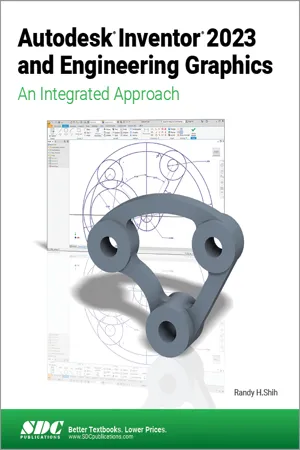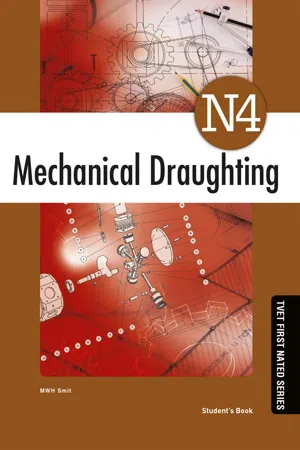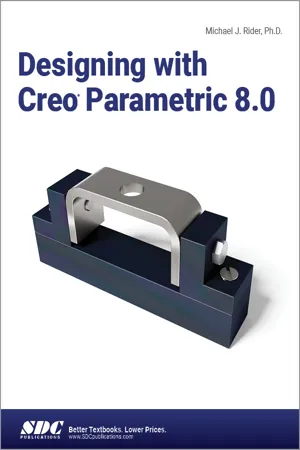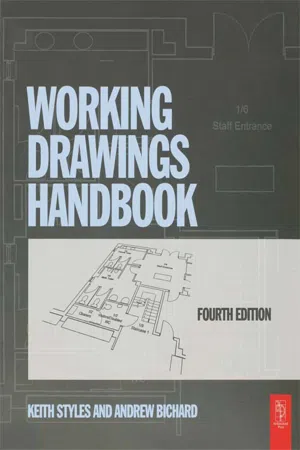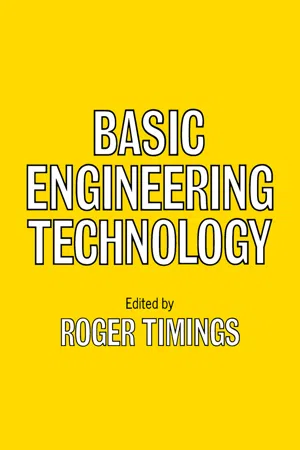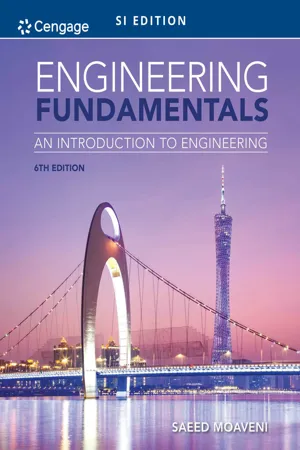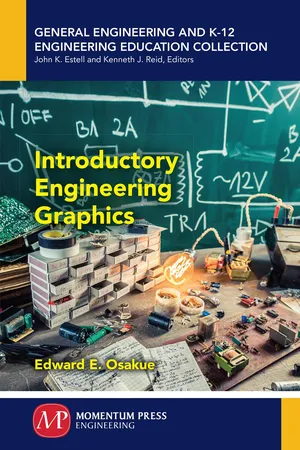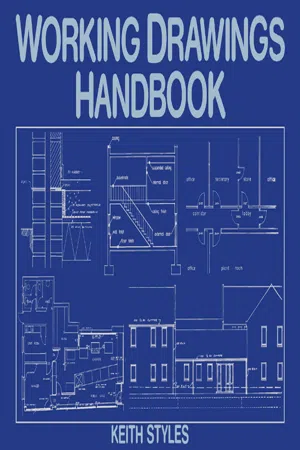Technology & Engineering
Assembly Drawing
An assembly drawing is a technical illustration that shows how various parts and components fit together to create a complete product or structure. It provides a visual guide for assembling the individual parts and often includes labels, part numbers, and other relevant information to aid in the construction process. These drawings are commonly used in manufacturing and engineering to communicate the assembly process.
Written by Perlego with AI-assistance
Related key terms
1 of 5
10 Key excerpts on "Assembly Drawing"
- eBook - PDF
Engineering Applications
A Project Resource Book
- Graham Simpson, James Ritchie(Authors)
- 2012(Publication Date)
- Butterworth-Heinemann(Publisher)
This is where the final two types of drawing, namely Assembly Drawings and detail drawings, have parts to play. 2.2.3 Assembly Drawings and detail part drawings Formal engineering drawings, fully dimensioned and specified, are the main output from the engineering design process. Their main purposes are: • to communicate the information required to enable the creation of manufacturing assembly and detail part process plans • to communicate the design requirements to the shop floor and suppliers • to convey to the customer the product form. It is important that these drawings are produced in a format which is readily understood by all concerned. It is for this reason that a number of standards, both national and international, have been developed to aid engineers in the presentation of design information, e.g. BS308 [4]. The drawings arising from projects in this book should always be drawn to the appropriate national standard, in orthographic 3rd-angle projection. A typical Assembly Drawing (also known as the general arrangement drawing) is shown in Figure 2.6. This shows the overall outline of the finished product assembly and the way in which the parts fit together. It gives the key overall dimensions, any limiting functional dimensions of moving parts and a parts list or bill-of-material. The latter, which may be drawn in a table on the original drawing or written on a separate sheet, lists all the subassemblies, manufactured detail parts and proprietary items which go into making the final assembly. The detail parts in the subassemblies are not mentioned in the parts list at this stage. Many assemblies will require subAssembly Drawings which take the same form and specify the subassemblies and other parts associated with them, and it is here that their detail requirements are listed on another parts list. - eBook - PDF
Autodesk Inventor 2023 and Engineering Graphics
An Integrated Approach
- Randy H. Shih(Author)
- 2022(Publication Date)
- SDC Publications(Publisher)
A successful detail drawing will provide the manufacturing department all the necessary information to produce the parts. This is done by providing adequate orthographic views together with dimensions, notes, and a descriptive title. Information on a detail drawing usually includes the shape, size, material and finish of a part; specific information of shop operations, such as the limits of accuracy and the number of parts needed are also provided. The detail drawing should be complete and also exact in description, so that a satisfactory part can be produced. The drawings created in the previous chapters are all detail drawings. Assembly Modeling and Working Drawings 14-5 Assembly Drawings An Assembly Drawing is, as its name implies, a drawing of the design put together, showing the relative positions of the different parts. The Assembly Drawing of a finalized design is generally done after the detail drawings are completed. The Assembly Drawing can be made by tracing from the detail drawings. The Assembly Drawing can also be drawn from the dimensions of the detail drawings; this provides a valuable check on the correctness of the detail drawings. The Assembly Drawing sometimes gives the overall dimensions and dimensions that can be used to aid the assembly of the design. However, many Assembly Drawings need no dimensions. An Assembly Drawing should not be overloaded with detail, particularly hidden detail. Unnecessary dashed lines (hidden lines) should not be used on any drawing; this is even more critical on Assembly Drawings. Assembly Drawings usually have reference letters or numbers designating the different parts. These “numbers” are typically enclosed in circles (“balloons”) with a leader pointing to the part; these numbers are used in connection with the parts list and bill of materials. For complicated designs, besides the Assembly Drawing, subAssembly Drawings are generally used. - eBook - PDF
Mechanical Draughting N4 SB
TVET FIRST
- MWH Smit(Author)
- 2015(Publication Date)
- Macmillan(Publisher)
167 • An outline Assembly Drawing describes the exterior shape of a machine or device. It contains only the primary dimensions. If it is made for catalogues or illustrative purposes, dimensions are often omitted. Outline Assembly Drawings are also called installation drawings. • An assembly working drawing includes all the information required to produce a machine or structure on one drawing. It therefore needs to provide adequate orthographic views together with dimensions. • A diagram drawing shows symbolically the installation of equipment and is often made in pictorial form. Drawing Assembly Drawings The following examples illustrate how to construct Assembly Drawings from detail drawings: Example 5.1 Your company has to manufacture machine components and parts for a mining company. The detail drawings have been done, but the client needs to see an Assembly Drawing of the final product. The Assembly Drawing should include references to the parts in the detail drawing and a BOM. Figure 5.1 shows a final rendering of a crane coupling. Figure 5.2 shows an exploded view of the crane coupling. The exploded view provides instructions to the client for the assembly of the product. Figure 5.3 shows the detail drawings of the different parts of the crane coupling. It is now the task of the draughtsperson to assemble these parts into orthographic views in an Assembly Drawing that provides a clear understanding of the working and function of the crane coupling. An Assembly Drawing normally does not include symbols such as machining symbols or welding symbols. Notes The views of the detail drawings may be of mixed orientation. This means that the items may be drawn and placed in first angle or third angle orthographic projection on the same sheet. The views may also be any of the major views: front, top, left, right, back and bottom. - eBook - PDF
- Michael J. Rider Ph.D.(Author)
- 2021(Publication Date)
- SDC Publications(Publisher)
340 CHAPTER 10 Assembly Drawings Figure 10‐1 Assembly Drawing Figure 10‐2 SubAssembly Drawing Assembly Drawings Explored 341 Figure 10‐3 Exploded Assembly View Figure 10‐4 Two Orthographic Views 342 CHAPTER 10 Assembly Drawings Figure 10‐5 Assembly with Sectioned View not sectioned or “in the round.” These parts include screws, bolts, nuts, keys, pins, ball or roller bearings, gear teeth, and spokes. Hidden lines are often left out of an Assembly Drawing since the relationship between parts is the Assembly Drawing’s main purpose. Hidden lines may tend to confuse the desired detail. The purpose of a detailed drawing is to describe the size or shape of any part. Dimensions are shown on the detailed drawings; thus they are not included on the Assembly Drawing. A dimension can be shown on an Assembly Drawing if it indicates the amount of travel allowed by a given part or the overall height or width of the complete assembly. Keep this distinction in mind. Parts are identified by placing a number inside a circle or balloon near the part with a leader line attaching it to the part. The circled numbers should be placed on the drawing in an orderly clockwise or counter-clockwise fashion. The balloon’s leader lines should never cross one another. Leader lines close to each other should be approximately parallel. A parts list, sometimes called a bill of materials, should include the part numbers, a description of the part, whether it is a subassembly or a part, and the required number of pieces. The parts list can be located in the upper right corner (Figure 10-6) or lower right corner of the drawing, or be located on a separate sheet. The border and title block for an Assembly Drawing should be the same as that for an engineering detailed drawing with one exception. In the title block for a detailed drawing, the part’s material is listed. - eBook - ePub
- Keith Styles, Andrew Bichard(Authors)
- 2012(Publication Date)
- Routledge(Publisher)
3.12, part of Foster Associates’ highly sophisticated detailing for the Willis, Faber and Dumas head office building in Ipswich, is another. A world of technology lies between them, but each drawing has in common that it defines how a number of component parts are to be put together.3.7 Shelving treated as a component rather than as an assembly. An example of common sense overriding too rigid theories of classification3.8 Component detail of concrete sill3.9 Component drawing of different doorsets all cross-referenced back to standard sub-component drawing 3.10With the Assembly Drawing we come to the very heart of the information package. If the general arrangement drawing is in many ways simply an ordered confirmation of planning decisions made long before, and the components drawing is frequently a documentation of the architect's judicious selection, the Assembly Drawing poses that most searching of all our questions, ‘How is it going to be built?’ Before attempting to document his answer in a manner which is going to be acceptable to the users of the document, the detailer must not only be confident that he knows the answer but also be aware of the full implications of the question.3.10 Sub-component drawing illustrating details of the component itself. (Original scale full size)It was stated at the outset that this book is not intended as a textbook on building construction but it would be futile to pretend that the preparation of a set of working drawings can be regarded as an academic exercise, to be undertaken without reference to its content. Clearly, form and content interact, and the point is raised now because it is precisely here, in the area of assembly detailing, that the really fundamental questions of adequacy emerge:• Will the construction function adequately? • Is the method of presentation adequate? • Does the range of detailing anticipate adequately all the constructional problems that will be encountered by someone trying to erect the building?Check lists are of limited value. There is really no substitute for the complete involvement of the detailer in his task, for an intelligent anticipation of the possible difficulties, and for an alert awareness of the total problem while individual aspects of it are being dealt with. Nevertheless, it is useful at times to review one's work formally, if only because to do so concentrates the mind wonderfully. Since two distinct aspects of detailing are involved, two lists may be formulated. - eBook - PDF
- R L Timings(Author)
- 2014(Publication Date)
- Butterworth-Heinemann(Publisher)
9 Interpreting drawings, specifications and data 9.1 Purpose of technical drawings Designers use technical drawings and speci-fications prepared by draughtspersons to convey their ideas and intentions to such people as: Manufacturing engineers Maintenance/service engineers Sales engineers Customers. These technical drawings and specifications will vary depending upon for whom they are intended. The manufacturing engineer will want orthogra-phic detail and Assembly Drawings. The service engineer will require exploded views. The cus-tomer will require installation drawings and oper-ating data. Examples of these various types of drawing will be found later in this chapter. Technical drawings and specifications should indicate such information as: (a) The size and shape of the component (b) The material from which it is to be made (c) The finish (corrosion resistant, decorative etc.) (d) The relationship between the component and associated components in an assembly. In addition to the above, data must be provided to give guidance as to: (e) The method of manufacture (operation se-quence) (f) The sequence for assembly and dismantling (g) Installation and operation (h) Performance compared with competing equipment for the benefit of the sales engi-neer. To achieve all these requirements, various types of drawings are widely used. Visual representations avoid the confusion arising in translation from one language to another. Moreover, a drawing is more clear and concise and less open to misinterpre-tation than a verbal description. Most people have a natural instinct for appearance and proportion, and there is much truth in the saying that Tf a product looks right, it is right'. The designer must consider the function and fitness for purpose of a product; in addition, he or she must have a flair for styling and eye appeal, so that the product is attractive to the potential customer. This is par-ticularly important when designing for the general public. - eBook - PDF
Engineering Fundamentals
An Introduction to Engineering, SI Edition
- Saeed Moaveni(Author)
- 2019(Publication Date)
- Cengage Learning EMEA(Publisher)
3.2 m m 1 2 3 PLACE DIMS: PLACE DIMS: PLACE DIMS: ANGULAR: FRACTIONAL: FINISH: FIRST USED ON: SIMILAR TO: Copyright 2020 Cengage Learning. All Rights Reserved. May not be copied, scanned, or duplicated, in whole or in part. Due to electronic rights, some third party content may be suppressed from the eBook and/or eChapter(s). Editorial review has deemed that any suppressed content does not materially affect the overall learning experience. Cengage Learning reserves the right to remove additional content at any time if subsequent rights restrictions require it. 639 Discussion Starter Conveying Information to other Engineers, Machinists, Technicians, and Managers E ngineers use technical drawings to convey useful information to others in a standard manner. An engineering drawing provides information, such as the shape of a product, its dimensions, materials to be used to fabricate the product, and assembly steps. Today, with solid-modeling software, we can create mod- els of objects with surfaces and volumes that look almost indistinguishable from the actual objects. The solid-modeling software allows for experimenting on a computer screen with the assembly of parts to examine any unforeseen problems before the parts are actually made and assembled. Some engineering drawings are specific to a particular discipline. For example, civil engineers deal with land or boundary, topo- graphic, construction, and route survey draw- ings. Electrical and electronic engineers, on the other hand, could deal with printed circuit- board Assembly Drawings, printed circuit-board drill plans, and wiring diagrams. Engineers also use special symbols and signs to convey their ideas, and show analyses and solutions to prob- lems. A good grasp of these principles will enable you to convey and understand information effectively. - eBook - ePub
- Edward E. Osakue(Author)
- 2018(Publication Date)
- Momentum Press(Publisher)
CHAPTER 7 WORKING DRAWINGS7.1 INTRODUCTIONA working drawing is a special type of engineering drawing created for use as a production or construction document. Therefore, it is also called a production or construction drawing. The design, manufacture, assembly, operation, and maintenance of engineered products need proper documentation, and working drawings are the instruments used. They are employed for the technical documentation and communication of design intent for simple to complex assemblies. Working drawings are fundamental in manufacturing and construction businesses and are considered to be legal documents. Quality, correctness, and completeness are paramount in their preparation. Due to the globalization of the economy and technology and the increasingly growing popularity of metric system in most countries of the world, working drawings should be preferably prepared in metric units, especially in new projects.Designed products usually consist of standard and nonstandard (custom) components or parts. Standard parts are generally purchased from vendors, while custom parts are manufactured in-house or contracted out. Each nonstandard part in an assembly or subassembly must have a detail drawing. However, standard parts in an Assembly Drawing do not need detail drawings, but proper specifications for each of them must be provided. Specifications are written instructions in working drawings, and they provide technical requirement information on parts, manufacturing, and assembling processes. They may include material type and grade, processing methods, surface finish, and so on. Specifications may appear as general notes or are put together as separate document. They should be clear and easy to understand. The design drafter should add specifications to a working drawing as needed, but the correctness of the specifications is the responsibility of the designer or engineer.Practically, a design project will produce several drawings. These are usually bundled together and delivered to a client as a set. A drawing set should completely communicate the design intent and consists of detail and Assembly Drawings. Detail drawings are prepared often as multiple 2D views drawings of a single component in one sheet. Having multiple detail drawings on a single sheet is discouraged due to the changes that may occur in some components. Assembly Drawings are prepared for mechanisms, units (subassemblies), and products. They show the relative positions of components when assembled for functional use. An Assembly Drawing must include all parts in a product which must be listed in a bill of materials (BOM) or parts list. - eBook - ePub
- Edward E. Osakue(Author)
- 2018(Publication Date)
- Momentum Press(Publisher)
Designed products usually consist of standard and nonstandard (custom) components or parts. Standard parts are generally purchased from vendors, while custom parts are manufactured in-house or contracted out. Each nonstandard part in an assembly or subassembly must have a detail drawing. However, standard parts in an Assembly Drawing do not need detail drawings, but proper specifications for each of them must be provided. Specifications are written instructions in working drawings, and they provide technical requirement information on parts, manufacturing, and assembling processes. They may include material type and grade, processing methods, surface finish, and so on. Specifications may appear as general notes or are put together as separate document. They should be clear and easily understood. The design drafter should add specifications to a working drawing as needed, but the correctness of the specifications is the responsibility of the designer or engineer.Practically, a design project will produce several drawings. These are usually bundled together and delivered to a client as a set. A drawing set should completely communicate the design intent and consists of detail and Assembly Drawings. Detail drawings are prepared often as multiple 2D views drawings of a single component in one sheet. Having multiple detail drawings on a single sheet is discouraged due to the changes that may occur in some components. Assembly Drawings are prepared for mechanisms, units (subassemblies), and products. They show the relative positions of components when assembled for functional use. An Assembly Drawing must include all parts in a product which must be listed in a bill of materials (BOM) or parts list.10.2 ELEMENTS OF WORKING DRAWINGSWorking drawings consist of drawing views and annotations. They must have complete dimensions, tolerances, and notes for construction, manufacturing, and inspection. The elements usually found on a working drawing include:(a) Drawing views(b) Title block(c) Name of part or assembly(d) Quantity(e) Part number(f) Material and grade(g) Dimensions(h) Tolerances(i) Scale(j) Notes(k) Drawing number(l) Revision(m) Project number(n) Assembly number(o) Zone markers(p) Surface quality10.2.1DRAWING VIEWSThe drawing views in a working drawing are the required graphic images of the product model. The drawing views depend on the type of documentation required, and annotation content will vary accordingly. The standard 2D orthographic views are front, top, and right views in North America based on 3rd angle projection. Auxiliary and sections views may be used to supplement standard views for more details and clarity. Figure 10.1 - eBook - PDF
- Keith Styles(Author)
- 2014(Publication Date)
- Architectural Press(Publisher)
TYPES OF DRAWING 33 42 42 12 12 EX 100 X 63 52 57 S C (32) 0 1 7 45 30 52 52 19 42 12 EX 100 X 63 56 19 EX 50 X 32 19 EX I100X22 1 I I I I - -H 1 94 52 42 12 EX 100 X 50 14 19 SC(32)019 3ft 94 38 EX 50 X 32 26 SC(32)018 26 SC(32)020 2.35 Sub-component drawing illustrates constructional details of the component itself (scale full size) 53 WORKING DRAWINGS HANDBOOK 2 .36 Assembly detail from PSA Standard Library 54 S3HSINId dOd 3QVdS NOISNSWIO ONmoaiNoo vi d3S toie-na I I I ^ 300 5 MARGIN 255 |H EXTERNAL WALL SEE DETAIL A (21) B U - 3101 SEP 7 4 _ 2.37 Assembly detail from Willis Faber and Dumas Head Office Building (Foster Associates) With the Assembly Drawing we arrive at the very heart of the information package. If the location drawing is in many ways simply an ordered confirmation in building terms of planning decisions made long before, whilst the component drawing is frequently a documentation of the architect's judicious selection, the Assembly Drawing poses that most searching of all our questions, 'How is it to be built?'. Before he attempts to document his answer in a manner which is going to be acceptable to the users of the document, the detailer must not only be confident that he knows the answer, but also that he is aware of the full implications of the question. It was stated at the outset that this book is not intended as a textbook on building construction, but it would be futile to pretend that the preparation of a set of working drawings can be regarded as an academic exercise, to be undertaken without reference to its content.
Index pages curate the most relevant extracts from our library of academic textbooks. They’ve been created using an in-house natural language model (NLM), each adding context and meaning to key research topics.

